
Chrysothamnus, known as rabbitbrush, rabbitbush, and chamisa, are a genus of shrubs in the family Asteraceae. The native distribution is in the arid western United States, Canada, and northern Mexico. It is known for its bright white or yellow flowers in late summer.

Isocoma, commonly called jimmyweed or goldenweed, is a genus of North American semi-woody shrubs in the family Asteraceae. It is found in the semi-arid areas of Southwestern United States and Mexico.
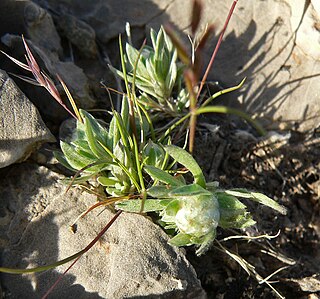
Stylocline(neststraw) is a small genus of North American desert plants in the tribe Gnaphalieae within the family Asteraceae.
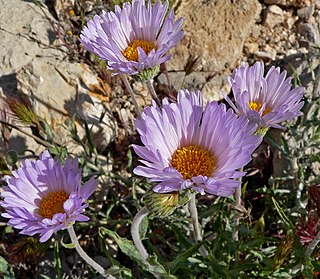
Xylorhiza is a genus of flowering plants in the family Asteraceae, known as woodyasters. These are daisylike wildflowers usually having blue to purple or white ray flowers with yellow centers of disc florets. Woodyasters are native to western North America.

Achyronychia is a monotypic genus of flowering plant containing the single species Achyronychia cooperi, which is known by the common names onyxflower and frost-mat. This plant is native to the Mojave and Sonoran Deserts of northern Mexico and the U.S. states of California, Nevada, Utah and Arizona. In California, it is known from San Diego, Imperial, Riverside, Los Angeles, San Bernardino and Inyo Counties. In Arizona, it occurs in Yuma, Mohave, Pima, Pinal and Maricopa Counties. It has also been reported from Washington County in Utah, and from Clark County, Nevada.
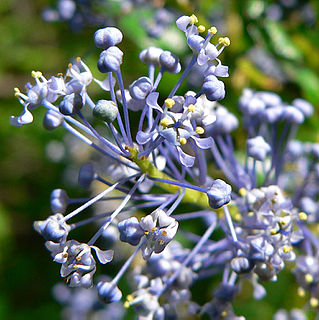
Ceanothus cyaneus is a species of flowering shrub in the genus Ceanothus known commonly as the San Diego buckbrush and Lakeside ceanothus. This species is found in the Peninsular Ranges of San Diego County, California, and known from one occurrence in Baja California. It is characterized by brilliant blue flowers, glossy green foliage, and is regarded as one of the most beautiful members of the genus.

Cirsium occidentale, with the common name cobweb thistle or cobwebby thistle, is a North American species of thistle in the family Asteraceae.
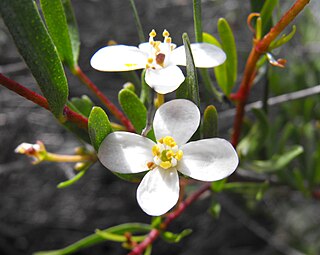
Cneoridium is a monotypic genus in the citrus family which contains the single species Cneoridium dumosum, commonly known as bushrue or coast spice bush. This perennial, evergreen shrub is native to the coast of southern California and Baja California, thriving in hot, dry conditions. This plant is characterized by a distinctive citrusy aroma and small, white flowers that appear from winter to spring. The flowers eventually become round berries that resemble a miniature version of the common citrus fruit.
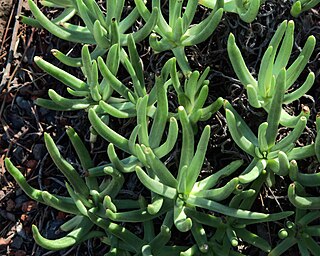
Dudleya edulis is a species of perennial succulent plant known by the common names fingertips, lady fingers, mission lettuce and the San Diego dudleya. The common name denotes the finger-like shape of the leaves, while the specific epithet edulis refers to the use of the young scapes as food by the Kumeyaay. It is native to Southern California and northern Baja California, and grows on rocky hillsides, cliffs, and bare rock.

Erigeron foliosus, known by the common names leafy daisy and leafy fleabane, is a North American species of flowering plants in the family Asteraceae.

Euphorbia misera is a semi-succulent shrub in the genus Euphorbia commonly known as the cliff spurge or coast spurge. A drought-deciduous shrub, it is typically found as a gnarled, straggly plant occupying seashore bluffs, hills and deserts. Like other members of its genus, it has a milky sap, which can be found exuding out of the light gray bark when damaged. The alternately-arranged leaves are round and folded in the middle, with small hairs on them. The "flowers" can be found blooming year-round, and are colored maroon or yellow in the center with 5 white to light-yellow petal-like appendages attached outside. This species is native to the Baja California peninsula and Sonora in Mexico, and the coast of southern California in the United States, where it is a rare species. It is threatened in some localities by the development of its coastal habitat, which tends to be prime locations for high-end residential and commercial developments.

Heterotheca sessiliflora is a species of flowering plant in the family Asteraceae known by the common name sessileflower false goldenaster. It is native to California, Sonora, and Baja California.
Lagophylla glandulosa is a species of flowering plant in the family Asteraceae known by the common name glandular hareleaf. It is endemic to California, where it grows in the Central Valley and foothills in chaparral, grassland and woodland habitat. This is an annual herb growing a very thin stem covered in glandular hairs, especially at the top in the inflorescence. The leaves are mostly small, smooth-edged, and glandular-hairy on the top of the stem, with much larger, toothed leaves toward the base. The inflorescence bears flower heads with five bright yellow ray florets, each with three lobes. The center of the head contains six disc florets which are yellow with black anthers. The fruit is a dark brown achene with no pappus.
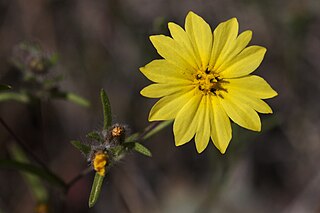
Lagophylla minor is a species of flowering plant in the family Asteraceae known by the common name lesser hareleaf. It is endemic to California, where it grows in the foothills surrounding the Sacramento Valley. It is a member of the plant communities growing on serpentine soils. This is an annual herb producing a thin, forking, purplish brown stem covered in small stiff hairs. The hairy leaves are 2 to 5 centimeters long and linear in shape, those on the lower stem toothed and those on the upper smooth-edged. The inflorescence bears flower heads with five bright yellow three-lobed ray florets, six yellow disc florets with black anthers, and phyllaries with long, soft hairs. The fruit is a glossy black achene two to three millimeters long.

Lagophylla ramosissima is a species of flowering plant in the family Asteraceae. It is known by the common name branched hareleaf, or branched lagophylla. It is native to the western United States where it can be found in many types of habitat, especially in dry areas. This is an annual herb producing spindly, erect stems which are variable in height. The leaves on the lower part of the plant are up to 12 centimeters long and fall off the plant early on in the season. The upper leaves are smaller and have woolly, glandular surfaces. The inflorescence is sparsely flowered in flower heads which open in the evening and close early in the morning. Each small head has five short light yellow ray florets with lobed tips, and six yellow disc florets. The fruit is an achene a few millimeters long with no pappus.

Camissoniopsis bistorta is a species of flowering plant in the evening primrose family known by the common names southern suncup and California suncup. It is native to southern California and Baja California, where it grows in several types of plant community along the coast and in the coastal hills and mountain ranges. This is a hairy annual or short-lived perennial herb spreading from a basal rosette, with stems reaching up to 80 centimeters long. The leaves are narrow and sometimes toothed, and 1 to 12 centimeters in length. Toward the end of the spreading stems are nodding inflorescences of flowers, each flower with four bright yellow petals dotted with red at their bases.
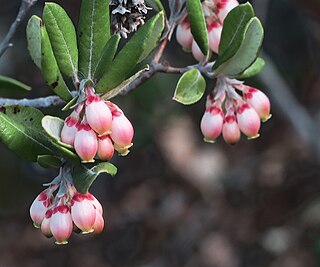
Xylococcus is a monotypic genus of flowering plants in the heather family which contains the single species Xylococcus bicolor, commonly known as the mission manzanita. It is a burl-forming, evergreen shrub to tree with leathery leaves and smooth dark reddish bark. From December to February, white to pink urn-shaped flowers adorn the foliage, often attracting hummingbird pollinators. It is native to southern California and the Baja California Peninsula, south to the Sierra de la Giganta. There is growing concern over the future of this plant, referred to as the "queen of the elfin forest, " as it may possibly lose up to 88% of its habitat and its wild seedlings are failing to survive more than a full year.

Malacothrix incana is an uncommon species of flowering plant in the family Asteraceae known by the common name dunedelion. It is endemic to California, where it grows only in sand dunes on the beaches of the Channel Islands and isolated spots along the mainland coastline in San Luis Obispo and Santa Barbara Counties. The type specimen was collected in San Diego, but the plant no longer occurs there.
Syntrichopappus is a genus of flowering plants in the family Asteraceae, found in the Southwestern United States and northern Mexico, including Baja California. It is a member of the Heliantheae alliance of the Asteraceae. There are two species. Common names include xerasid and Frémont's-gold.
Helianthus nuttalliisubsp. nuttallii, also known by the common name Nuttall's sunflower is a subspecies of Helianthus nuttallii in the genus Helianthus in the family Asteraceae. It is considered by The Plant List to be a synonym for H. nuttallii. However, The Jepson Manual argues that it is distinct from the species.

















